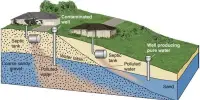An emission intensity is the rate of a given pollutant’s emission relative to the intensity of a specific activity or industrial production process; for example, grams of carbon dioxide released per megajoule of energy produced, or the ratio of greenhouse gas emissions produced to GDP. It is the quantity of greenhouse gas emissions produced per unit of a particular activity or output. It is frequently used to assess and compare the environmental impact of different processes, sectors, or activities.
Emission intensities are used to calculate estimates of air pollutant or greenhouse gas emissions based on the amount of fuel burned, the number of animals employed in animal husbandry, industrial production levels, distances traveled, or other activity data. Carbon dioxide (CO2), methane (CH4), and nitrous oxide (N2O) are the key greenhouse gases of concern because they are substantial contributors to climate change. The intensity of emissions can also be used to compare the environmental impact of various fuels or activities.
It is typically expressed in units such as:
- Carbon Dioxide Equivalent (CO2e): This is a common unit used to express the combined effect of all greenhouse gases in terms of the warming potential of carbon dioxide. It allows for a standardized comparison of emissions from different gases.
- Per Unit of Energy: It can be measured per unit of energy produced. For example, the emissions produced per megawatt-hour (MWh) of electricity generated from a power plant.
- Per Unit of Economic Output: It can also be measured per unit of economic output, such as emissions per dollar of gross domestic product (GDP).
- Per Capita: It can be measured on a per capita basis, which considers emissions relative to the population of a region or country.
The phrases emission factor and carbon intensity are sometimes used interchangeably. The terminology used varies depending on the field/industry sector; typically, the phrase “carbon” excludes additional pollutants such as particle emissions. Carbon intensity per kilowatt-hour (CIPK) is a regularly used statistic for comparing emissions from various electrical power sources.
The purpose of evaluating emission intensity is frequently to find opportunities for reducing emissions by improving operations or switching to greener energy sources. Lowering emission intensity is an important technique for mitigating climate change and lowering human activity’s carbon footprint.
Emission intensity data is used by governments, organizations, and researchers to monitor progress toward environmental targets, track the impact of policy initiatives, and make educated decisions about how to reduce emissions and promote sustainability.
















